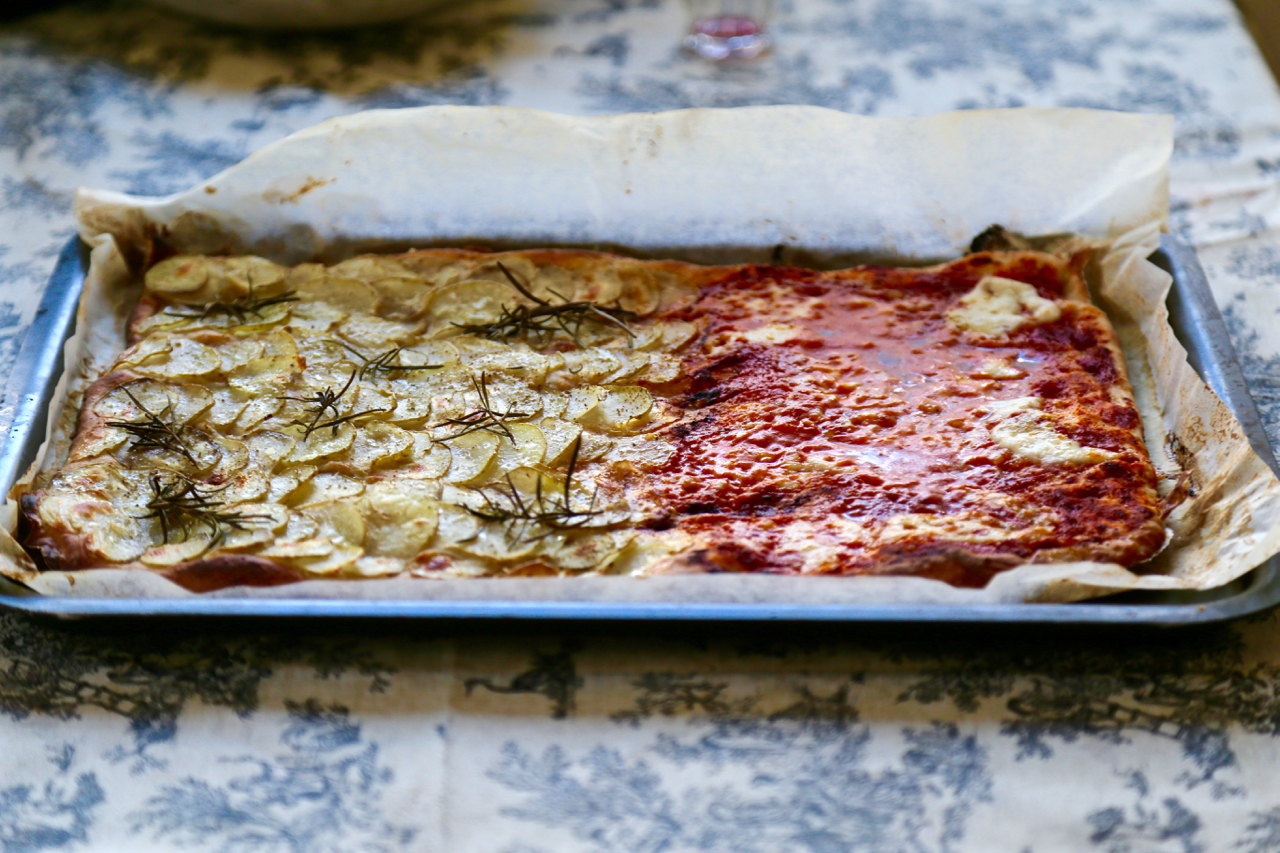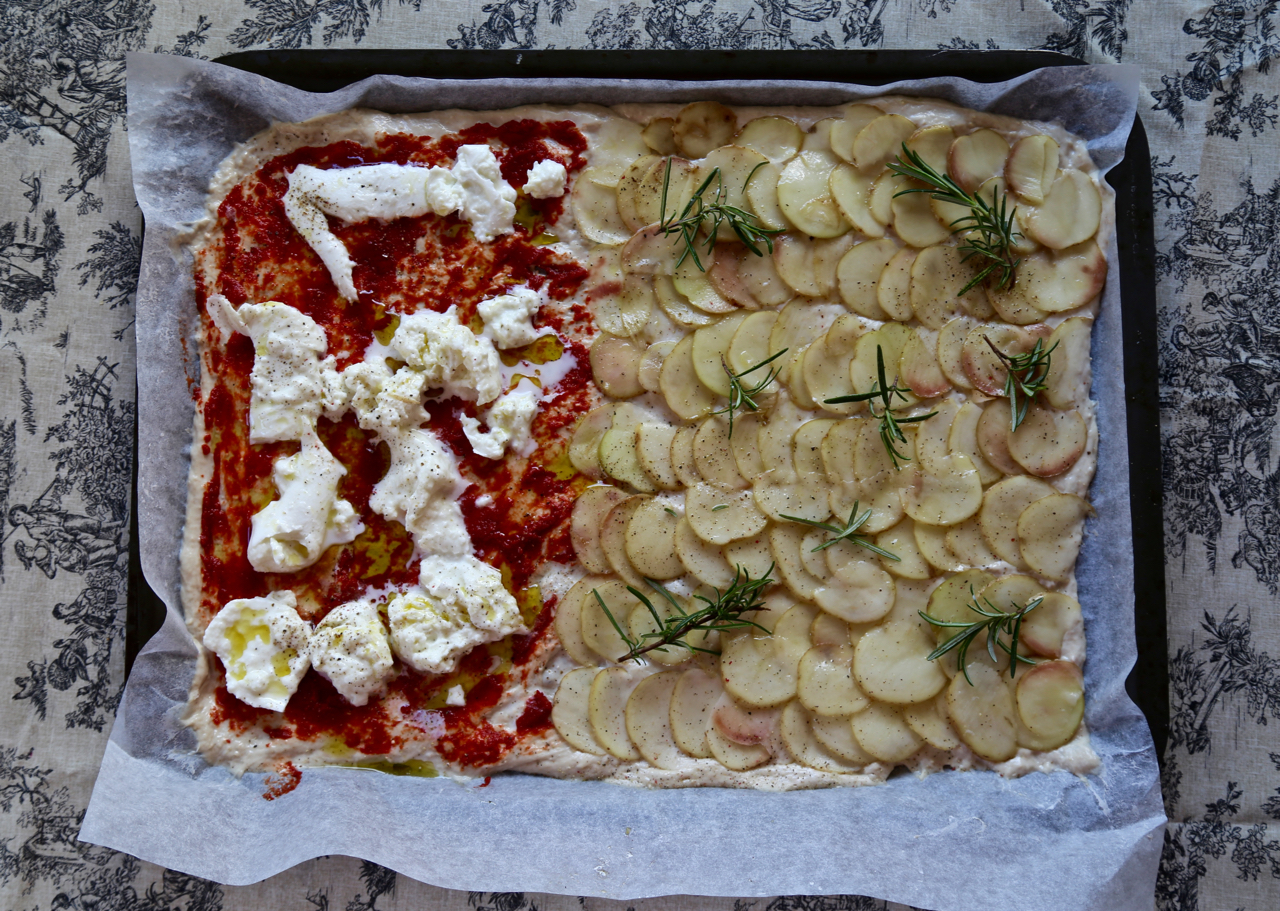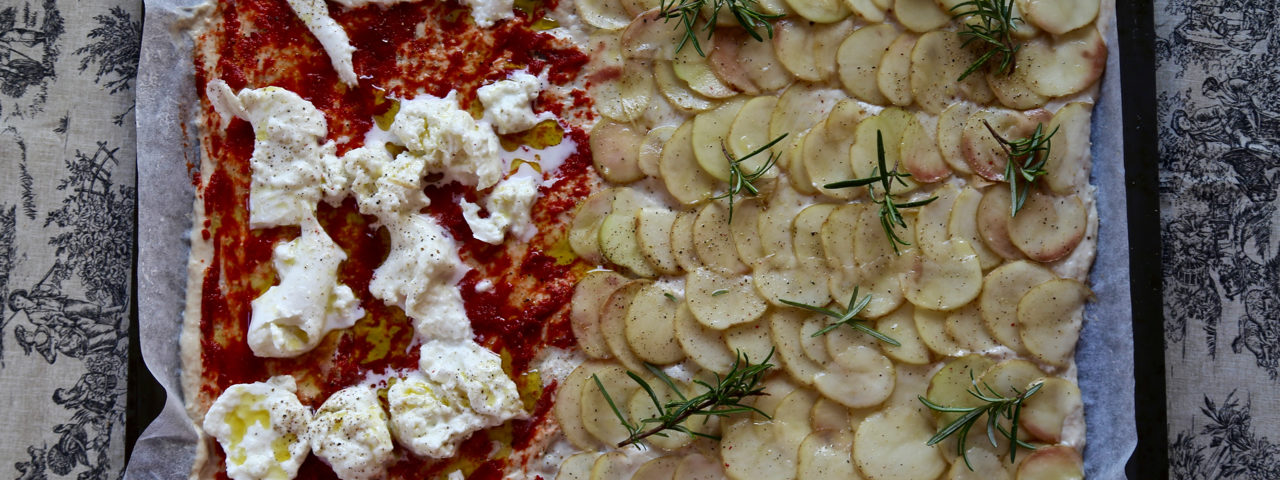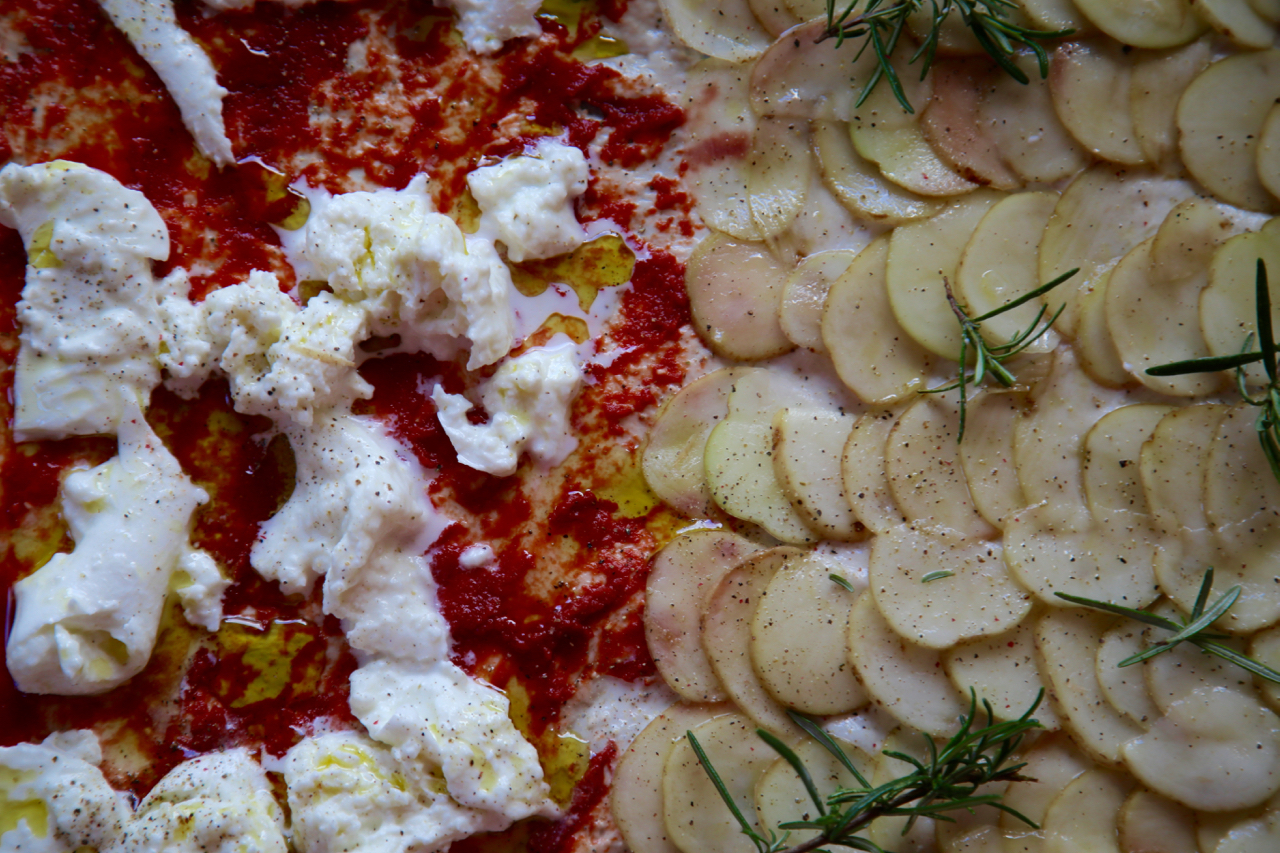[twitter style=”horizontal” float=”left”]
[fblike style=”standard” showfaces=”false” width=”450″ verb=”like” font=”arial”]

A thick new red book, virtually an encyclopaedia of pizza, has just been published called Where to Eat Pizza (Phaidon), by American author Daniel Young.
Pizza is probably the most popular fast food around the world. It’s almost one of the most profitable as the ingredients are fairly cheap. There are a million versions, from the original Italian and all the American styles (Chicago, New York, New Haven, thin crust, stuffed crust, etc) to more exotic genres such as Turkish Lahmacun and Georgian khachapuri.
What is a pizza? Is it a question of ingredients? Shape? Base? Structure?
It seems almost anything that is thin and flat with some kind of topping can be entitled pizza. Witness what the clean eating movement refers to as pizza – cauliflower crust, which is whizzed up cauliflower and almonds as a base.
Admittedly this isn’t the first book I’ve seen on pizza culture; back in 2014, I reviewed a guide to American pizza, Pizza, A Slice of American History (Voyageur) by ‘pizza journalist’ Liz Barrett, also a contributor to Where to eat Pizza. Who knew it was a whole profession?
But now you can go on pizza tours, enter pizza competitions, go to pizza school, visit a pizza museum, attend a pizza summit, get a degree in pizza, join pizza discussion forums (warning: very geeky, very macho, it has a ‘dough doctor’ and everything). There is an art to making pizza, but also artistry involved in the packaging. Scott Weiner has a collection of almost 1,000 pizza boxes, while photographer Luke Stephenson documents timeless pizza box art.
Which wines to drink with pizza?
Most wine experts agree that we match wine with the pizza topping. So if you have a tomato-based topping, go for red or rosé, but with the rarer white topping, opt for a white wine.
Here is a quick recipe for fail-proof pizza and a few wine suggestions from winetrust.co.uk.
For tomato-based pizza topping
For a red pizza, Italian wines are obviously ideal, though modern pizza is an American invention, so you could also try an American wine.
My recommendations include:
- 2012 ‘Fontodi’ Chianti Classico £22, deep fruity hearty wine.
- 2014 Allegrini Valpolicella £10.50 WineTrust Master of Wine Nick Adams regards this as the perfect pizza accompaniment. Not too heavy, bright and cherry-like.
- 2014 Montepulciano d’Abruzzo DOC Moda Talamonti £9.25 Well-priced bronze medal winner with spicy undertones of clove and soft black fruit.
- 2013 Domaine Drouhin, Pinot Noir, Willamette Valley, Oregon £24 I served this at Christmas and again last week with a large dish of tomatoey, garlicky pasta. It went down a treat. Soft and light, creamy but quite full-bodied. I’m a big fan of Oregon wines, having visited there a couple of years ago. Oregon is the new California (especially now with global warming) and many winemakers are seeking land further north.
For pizza bianco (white pizza)
This is less common but a lovely change from the classic Margarita or Napoletana-style toppings. Some white pizza, typically Roman, is just with olive oil and rosemary. There is also a delicious version with thinly sliced potatoes (yup, I know this is double carbing but it’s very, very good).
New Haven style pizza is white with clams and pecorino. But basically white pizza is any pizza without tomatoes.
- 2014 Fontaleoni Vernaccia Di San Gimignano £11.95 A gorgeously crisp Tuscan wine using an unusual Italian grape, ‘Vernaccia’, which has an interesting lineage. Experts can’t quite work out whether this grape was originally from Greece or Eastern Europe. Historians think this wine, referred to as ‘vernage’, may have been drunk in England during medieval times.
- 2014 La Guistiniana Gavi di Gavi ‘Montessora’ £22 A full-bodied white with minerality and a nicely judged acidity.

Recipe for thin base red and white pizza
This pizza means you can open two bottles of wine: one red and one white.
(Recipe inspired by Smitten Kitchen and Jim Lahey.)
Makes one large rectangular pizza, enough for 4
Base
250g strong flour or 00 flour
1 packet 7g of fast acting yeast
150ml lukewarm water
1/2 tsp salt
1/2 tsp sugar or honey
1 tbsp olive oil
2 tbsps coarse semolina, for sliding
Toppings
White:
4 small to medium potatoes, sliced very finely on a mandolin
Salt
Truffle oil or olive oil
A few rosemary sprigs
Red:
4 tbsp tomato paste
2 balls mozzarella, torn
Olive oil or basil oil
Salt
- Mix all of the base ingredients together by hand or, even easier, in a standmixer until soft, stretchy and pliable. To get that texture, mix it for longer than you think – a couple of minutes on a slow speed in a mixer then 5 minutes at a high speed. It should come together in a ball.
- Put the dough into a deep oiled bowl and cover with cling film or a plastic bag. Leave for an hour.
- Slice your potato slices as thinly as possible, then put them in a bowl of water with a tablespoon of salt. Leave to soak for half an hour.
- Preheat your oven to as high as it will go. At the same time, heat up the baking tin or pizza stone that you will be using to bake your pizza. This will prevent the potatoes from being starchy and sticky on the pizza. Double carbing is a fabulous indulgence, but the potato/pizza thing must be approached with care to achieve truly heavenly status.
- Once risen, stretch your pizza dough onto a sheet of parchment paper cut slightly larger than the size of your baking tin.
- Dry off the potato slices in kitchen paper or a clean tea towel.
- Toss the potato slices with truffle or olive oil and a little extra salt.
- Spread the toppings over the dough. For the red half, spread the tomato paste liberally, then tear balls of mozzarella over it and finally add the olive or basil oil. Place the potato slices, scallop-style, over the dough for the white half. Add the rosemary sprigs, more oil and more salt.
- Take the baking tin out of the oven and lift the pizza using the parchment paper onto the hot baking tin.
- Place in the hot oven for 10 to 15 minutes or until the potato seems cooked and crispy, turning the pizza around halfway through.
- Serve on top of the parchment straight onto the table, discarding the baking tin, and snip pieces with scissors, allowing everyone to have a choice of red, white or both.
More pizza tips
Flour: for pizza you should use high protein 00 flour, because you can buy 00 flour for pasta that is lower protein. While British flour is defined by strength (as in strong or plain), Italian flour is graded by the grind of the miller, so 00 flour is very finely ground.
I always check the packet to see the protein amount: if it’s under 11g then it’s mostly plain flour. For breads and pizza, you want to have more than 11g protein.
To serve: I’ve found that those wheelie pizza cutters are a waste of time. I use scissors!
Toppings
Great pizza is all about the ingredients. Spend money on these!
Tomatoes: Ideally you’d have incredibly ripe, fresh San Marzano tomatoes plucked from a field in Italy at the height of summer, which don’t even need cooking. But failing this, buy a decent tin of San Marzano (my piece in The Guardian on the best tinned tomatoes). If you have a good tin, then use a little olive oil, a crushed clove of garlic and a couple of fresh bay leaves and simmer for at least ten minutes. Spread over the pizza base when cooled down.
Cheese: Over the tomato base, tear rather than cut, good mozzarella; you know, the buffalo milk cheese not that rubbery Danish stuff. Don’t buy ready-grated either, the texture has dried out and it’s lost the flavour.
If you really want to go to town, buy burrata. Do you know about burrata? Sooooo goooood. Basically it’s mozzarella with double cream inside. It’s soft and creamy. It’s heavenly. Put that on last minute.
Olive oil: I use a little olive oil in the crust but too much means it won’t get crispy. Use good olive oil to dress the pizza.
Fresh basil: A few leaves of fresh basil on top looks nice and tastes great. I’ve recently used wild garlic leaves.
My favourite toppings are artichokes or dried chilli flakes. French people often have chilli oil on their pizza, I’m not too keen. I like my oil and my chilli separate.
Which wines do you like to drink with pizza? Or are you more of a beer person when it comes to this casual food?
[twitter style=”horizontal” float=”left”]
[fblike style=”standard” showfaces=”false” width=”450″ verb=”like” font=”arial”]


